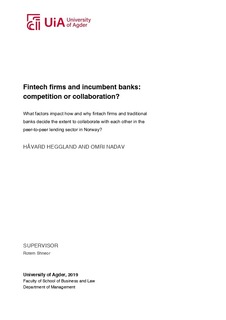| dc.description.abstract | Introduction: The fintech sector has grown from a narrow area of interest to become a major area of interest in Norway. Fintech firms and traditional banks seem to have a symbiotic relationship,with theircomplementary strengths contributing to the success of both parties. This paper therefore studiesthefactorsthatimpact the extent of collaboration between fintech firms and traditional banks, focusing on the peer-to-peer crowdlending sector in Norway. Methods:We adoptedaqualitative research design, using multiple-casestudyanalysis.Through a purposive sampling technique, we identified and carefully selected four fintech firms and three incumbent banks.We selected three scenarios:(1) those who have been chosen to remain separate(no collaboration between fintech firms and traditional banks),(2) collaborate as allies, choosing a strategic alliance strategy, or (3) selected a Mergers and Acquisitions strategy. We conducted seven in-depthinterviews in total,by usingsemi-structured interviews in an attempt to answerthe research question. We created a coding tree that helped us to both analyze the studiedcases and eventually aid in a cross-casecomparisonanalysis. In order to achieve triangulation and consistency concerning our findings, we collected complementary information through multiple sources: in-depth interviews and archival documentssuch as company websites, business reports and the news.Results:We have developed two research modelsfrom both the fintech firms’ and the banks’ perspective. Ourfinal model,from the fintech firms’ perspective,includes the following factors; regulation, trust, customer-centric approach, organizational cultural fit, strategic fit, innovation, capital, brand image, growth and expertise. From the banks’ perspective,we have identified the following factors; regulation, customer-centric approach, financial inclusion, organizational cultural fit, strategic fit, innovation, survivability, brand image, growth,risk management, expertise and profitability. Conclusions: Some identifiedfactors support earlier findings in the academic literature, while otherscontradict earlier findings. Additionally, we have identified factors that to the best of our knowledge,have not yet been identified intheliterature, concerning the studied phenomenon. Hence, we suggestthat these newly identified factors should be further investigated in a quantitative study. | nb_NO |

